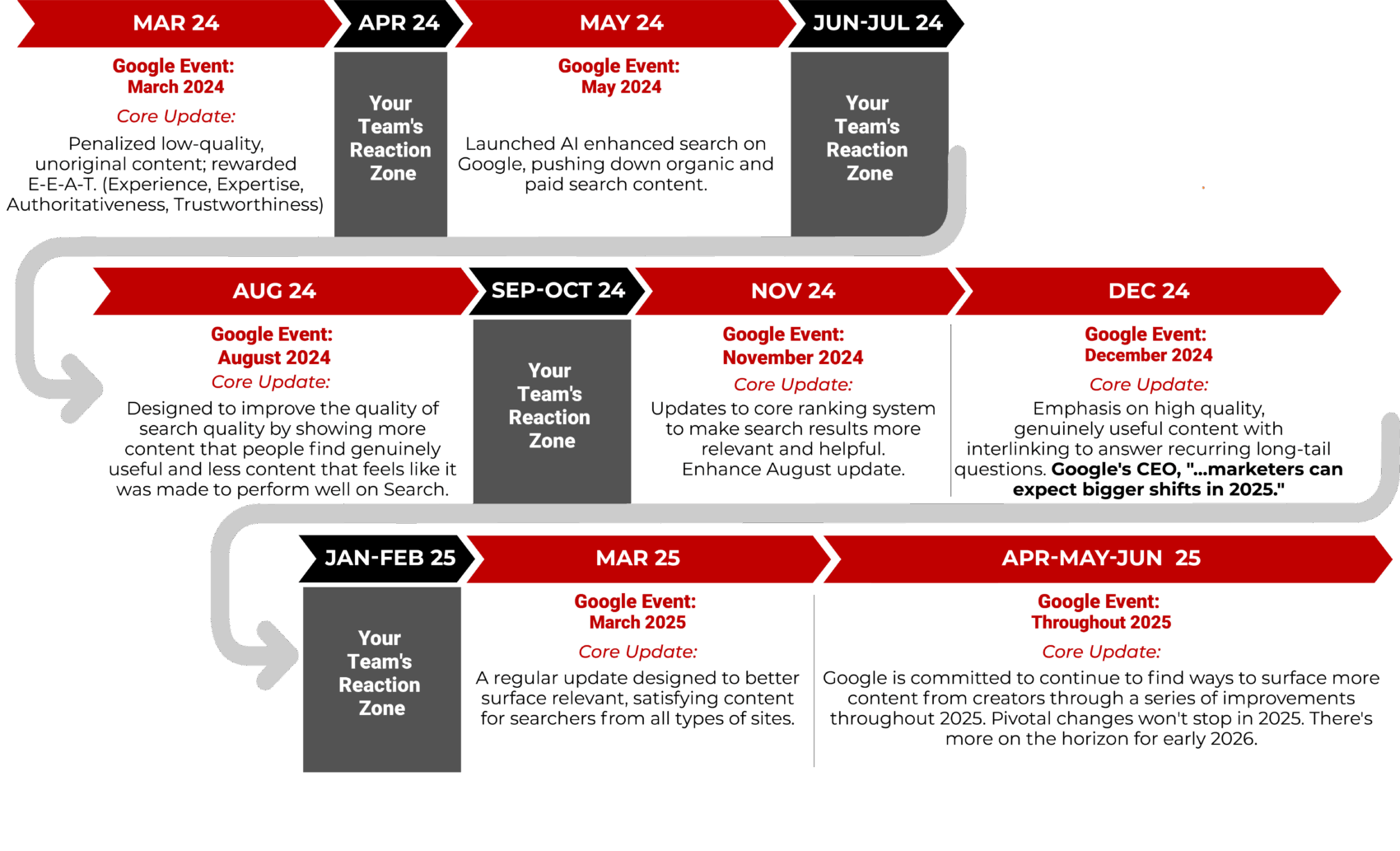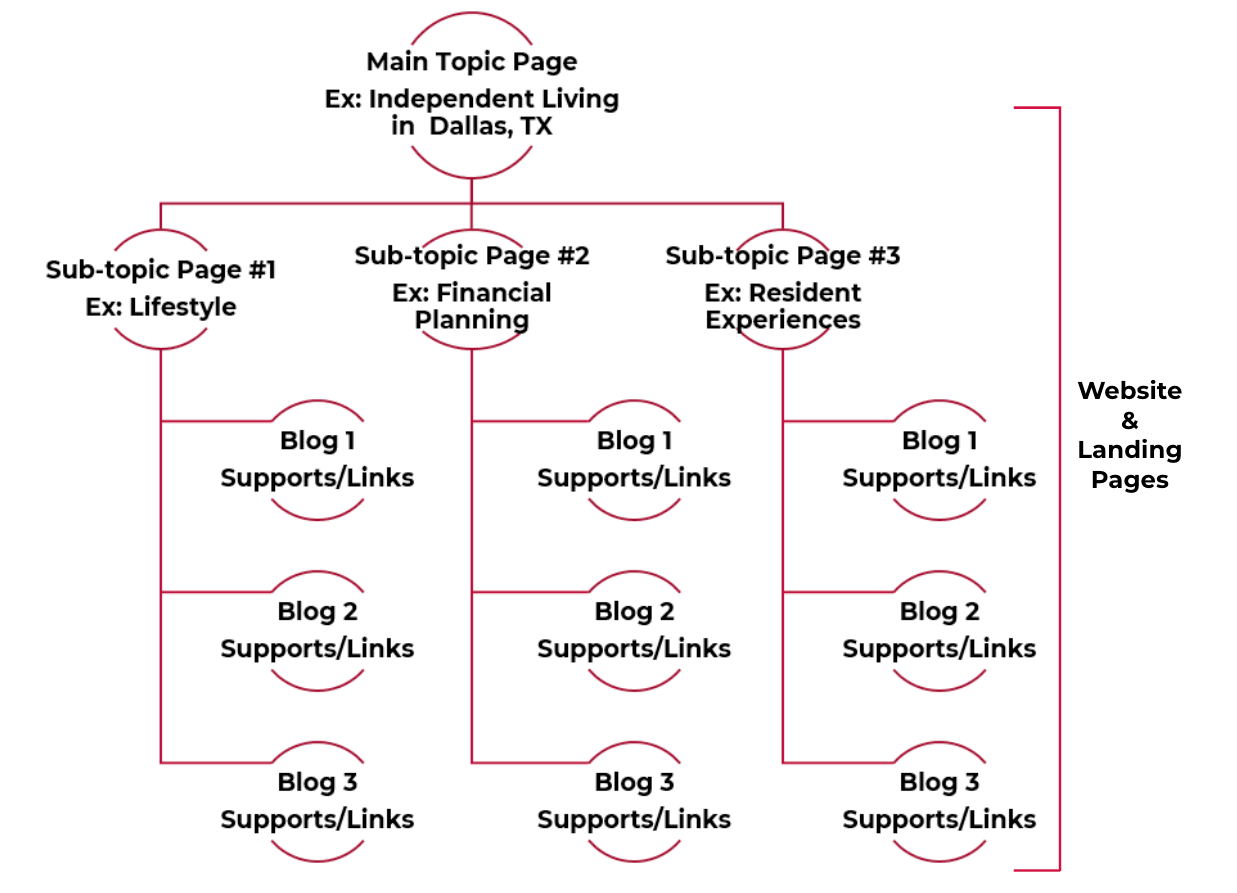I’ve been overseeing marketing strategies for Life Plan Communities long enough that I thought I’d seen every challenge in the book. But since AI technology came into the mainstream in 2024, the digital landscape has never … and will never … be the same.
Google is changing its guidelines at a pace no one inside or outside senior living is fully prepared for, and we’re all seeing firsthand how strategies that once delivered consistent lead results can suddenly stop performing. Despite the best efforts of marketing professionals everywhere, paid and organic lead volume are generally declining.
Like it or not, senior living is caught in the early stages of a paradigm shift in how people (including Life Plan Community prospects) search online and, as a result, how Google presents information to its searchers. This paradigm shift has only accelerated, and today many marketers are feeling the pain without understanding the root cause.
Until now.
Now, we can look back and see Google’s ongoing disruption to senior living’s traditional view of search. This chart gives a taste of the major, unannounced changes that have taken place in the past year.

The Painful Reality Many Marketers Are Facing
If you’re responsible for lead generation at your organization, you might recognize these symptoms:
- Your paid search campaigns aren’t delivering the same volume of leads they once did
- You’re consistently increasing your media budget but not seeing proportional results
- Your traditional SEO efforts aren’t translating to actual leads
- You’re struggling to reach prospects at different stages of their decision-making process
The root cause? The search results page itself has changed. Google’s integration of AI-generated “snapshots” is dominating the most visible part of the screen.
What’s particularly frustrating is that many marketers respond by doubling down on the same strategies, hoping for different results. But as Google continues to evolve its platform—with AI integration rapidly reshaping search as we know it—these challenges will only intensify.
Topic-Based Approach to Lead Generation (Not Just SEO)
Through our experience and extensive research, Love & Company has experimented with a topic-based approach to content marketing that offers a powerful solution to these challenges. But I want to be clear about something:
This is not purely an SEO strategy. There are SEO benefits to it, but this is fundamentally a lead generation strategy.
This distinction is crucial. When I explain this approach to clients who already work with SEO agencies, their first reaction is often, “But we already do SEO.” Once they understand that a topic-based content strategy is about comprehensive lead generation that works in tandem with paid media—and actually decreases reliance on paid media—the conversation shifts dramatically.
How The Topic-Based Strategy Works
At its core, a topic-based strategy:
- Addresses the entire decision-making journey—not just the final purchase stage
- Answers the long-tail questions prospects are actually asking
- Creates interconnected content that tells a complete story about your offerings
- Builds authority on specific topics relevant to your audience
- Drives both visibility AND conversions throughout the funnel
This approach recognizes that when people begin researching a product or service, they often start with lengthy, detailed questions. For example, someone might search: “What retail stores are available in this town or this state. And why do people there prefer that?” The chart below shares the concept visually.

By creating content that specifically addresses these longer queries, you capture prospects earlier in their journey. As they continue researching, their queries typically become shorter and more specific—and if you’ve established authority on the topic, your content continues to appear in their results.
Why This Matters More Than Ever
Google is actively changing how it delivers search results, prioritizing content that provides comprehensive answers to user questions. AI integration is accelerating this trend, while competitive regulatory pressure (including antitrust litigation) is driving Google to make its platform “the easiest and most user-friendly” for searchers, even if that means fewer clicks to your site.
For marketers, the takeaway is clear: If you’re not shifting and changing the way you deliver and interconnect your content so that it’s a full 360-story, then you’ve lost 80% of your audience.
Bringing It All Together
One way to think of a topic-based strategy is to liken it to funnel management. While funnel management might seem like an overused concept, it’s the language many marketing directors in the senior living field use. The question of “where are your prospects in the funnel and how do you reach them” is still fundamental. It just doesn’t address the full picture of how this strategy (aligning your content to the way your prospects ask questions) can impact your broader demand generation strategy.
A topic-based content strategy provides a comprehensive answer by:
- Creating visibility across all stages of the decision journey
- Decreasing reliance on increasingly expensive paid media
- Providing conversion opportunities at multiple touchpoints
- Building lasting authority that continues to deliver results
Looking back to 2024, when Google started making major, unannounced changes to its algorithms, Love & Company was hyper-aware when traditional lead generation started failing across the senior living field. So, we committed to understanding these shifts and developing strategies that work in this new reality. The result—a topic-based lead generation strategy, or more accurately demand generation, since it impacts leads at all points in the funnel—has transformed results for our clients and can do the same for your organization.
The digital marketing landscape will continue to evolve, but by focusing on comprehensive topic-based strategies rather than isolated tactics, you’ll be positioned to succeed regardless of what changes come next. I’ve discussed how to keep up with the changing environment, but few single-site and smaller multi-site organizations have the capacity to do so adequately. Love & Company offers a resource that summarizes the most current updates to the changing digital world here, which I update as the changes occur. We are also happy to discuss how a topic-based approach can revive and refine your overall demand generation strategy. If you’d like to discuss, contact Tim Bracken at tbracken@loveandcompany.com or schedule a short meeting here.





